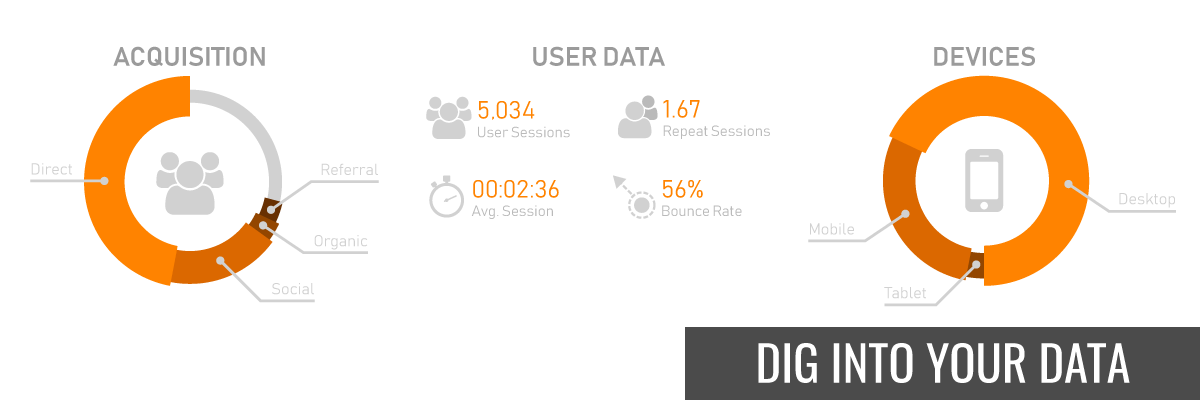Dig into your Data
I've worked in Design and Marketing for over 10 years and for both large companies and small. The notion use to be that small companies just make their products and sell them, but the internet is such a powerful tool for sales now that it's a mistake to ignore it.
If there's one reason we have done better than our peers in the internet space over the last six years, it is because we have focused like a laser on customer experience.
Don't just check a box on your "Things-To-Do List" by finishing a website. What do your customers need to know or see? The answer may be something that is different than you think. One of the reasons it is worth it to hire a designer or a marketer is that they have fresh eyes on your business. You might think its nice to see pictures of the work being done to produce the products, but your customers might want to see detailed, high-quality photos of your finished products. It's hard to know when you are so close to the business yourself.
During my career, I've seen a lot of sites that were designed horribly and sometimes had better results because of the "under the hood" work done on it. Search engines respond to this work more than style or design and search engines are what get your customers to you. You have to spend time on meta tags, titles, using keywords in your content and having a clean website without errors.
But what happens when you start getting traffic and the results aren't turning into sales or calls? The answer is that you need to work on the design, user experience, content, and your data.
DESIGN:
Do yourself a favor and hire a designer. We all think we have good taste, but you need to build a website that is attractive to the masses. Not just you. Get a few opinions on what the website should look like. Browse the internet for the websites that you think provide the experience that is good for you. Ask the designers you interview, trusted employees and friends the same question. There is a bit of a leap here to start down the road blindly, but it's worth spending some time up front getting some opinions of others. When hiring the designer be sure to require a wireframe (solid shapes that just show how the user navigates through the most important functions of your website), then a few rough designs, and finally a finished design that can be used by a coder.
USER EXPERIENCE:
The user experience (often referred to as UX) is probably the most key element for a website. This is why the wireframe (in the DESIGN step above) is so important. What is a user seeing when landing on your website? What should they be seeing? Are they seeing too much and therefore navigation decisions are too difficult? Is it important to have the About Us or Company History type pages up front when they land on your homepage or is that space more useful for the big decisions? Simplify their decision-making process as much as possible. Use size, color, and composition to move customers through your site and find what they need to make contact or make a purchase.
CONTENT:
The content of your site is a very important and ever-changing element to your site. You'd like to think that you will write some info about your products, service and you and your website will be finished. The reality is that search engines like to see new content with words and tags that are high on the search chart. This is one reason that blogs are so popular for getting rankings up. Blogs fill the hole of new content on a scheduled basis and they usually relate to the business or industry you are in, therefore using keywords that are being searched by people interested in that industry. It's a commitment, but it can bring traffic and therefore is important. If you need to you can hire writers online and as part of the contract make them call you and interview you for 15 minutes one day a week on a new favorite industry topic. At the end of the year, you would have 52 new blog entries all relating to your industry and adding to your search portfolio.
DATA:
Lastly, the thing this whole blog hinges on. Once your site is up and running it's very important to start learning about the retrievable data you can get off of users on your website. You can retrieve live data about how many users, where they are from, how they found you, what they are clicking, and a whole lot more. Once you can see all of this, it will help you with making changes to your site, how to best advertise, and maybe even what products people are interested in and where they might be leaving your website to go to a competitor.
I've started offering deals to my clients where I provide them with daily reports on their website's data so they don't have to bother themselves with managing the tools or using their valuable time to learn how to use the tools either. For $2 a day they get detailed reports delivered at the end of their business day. Like most data, we have learned valuable decision-making information when watching the customer experience over time.
Jimmy Johns
Experienced Graphic Designer with a demonstrated history of improving brand quality and presence.
Skilled in Design, Advertising, Integrated Marketing, and Branding.
